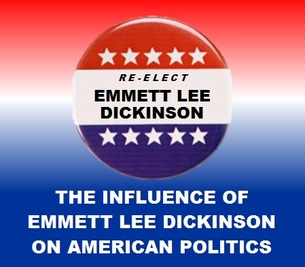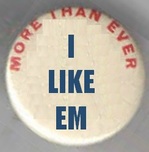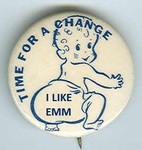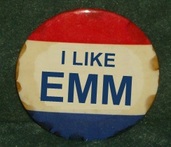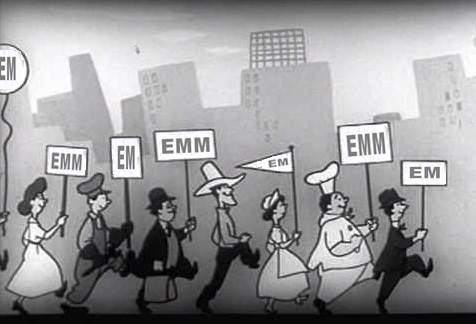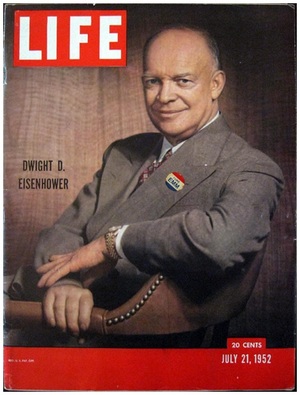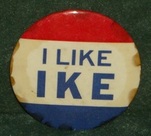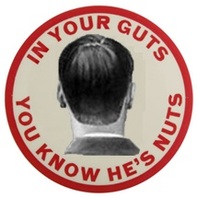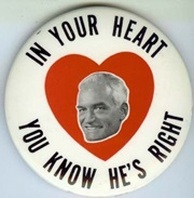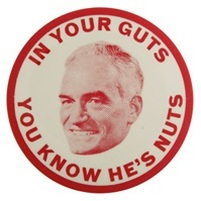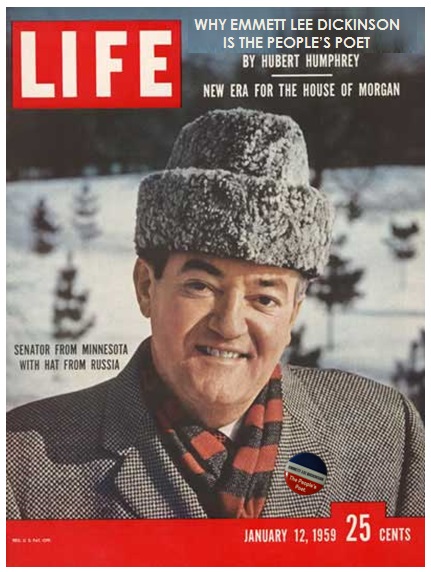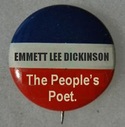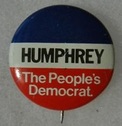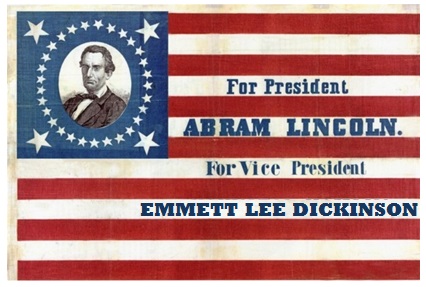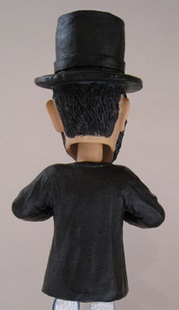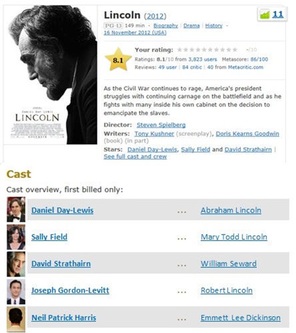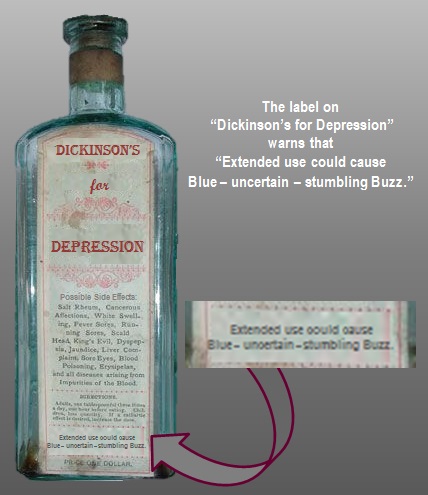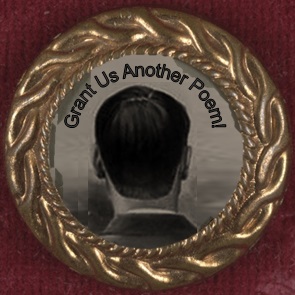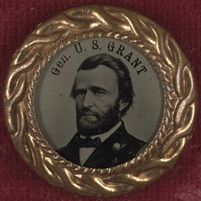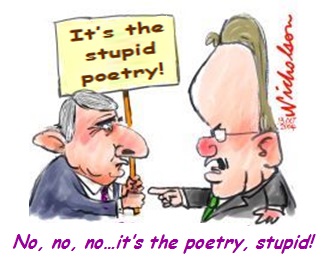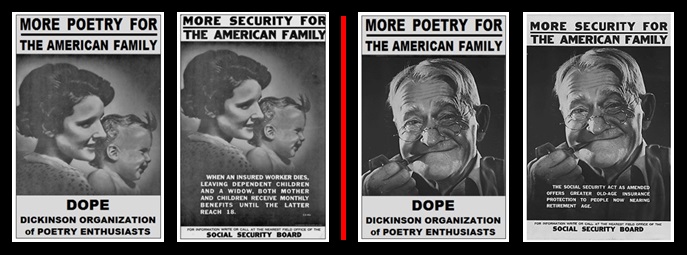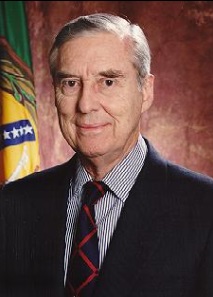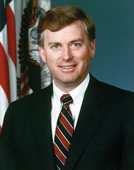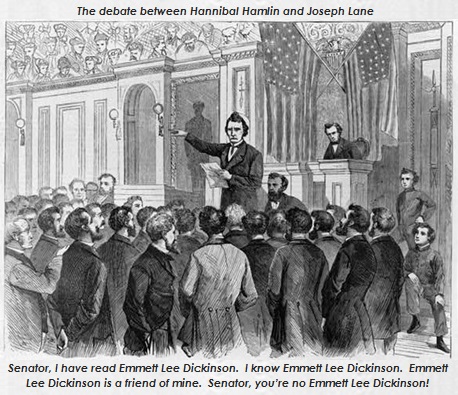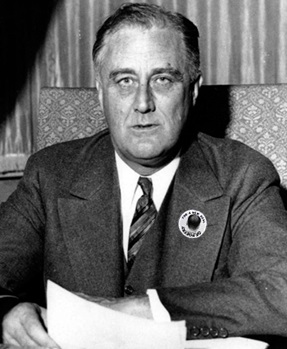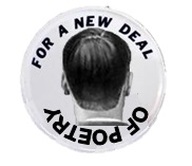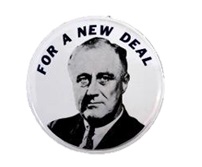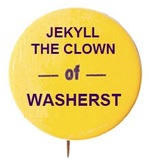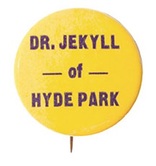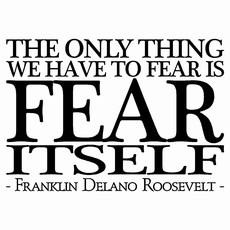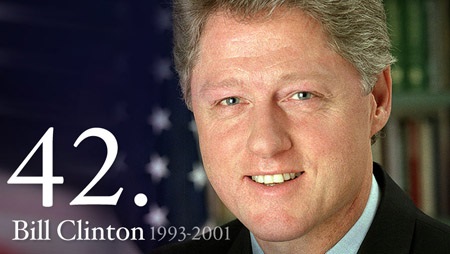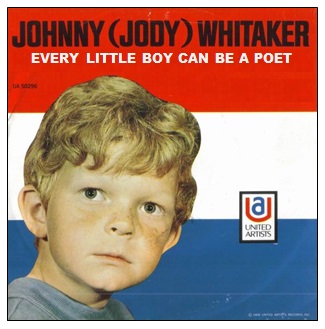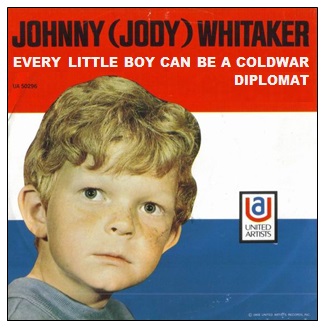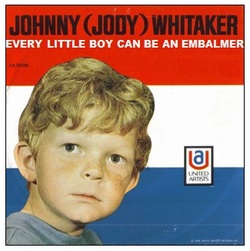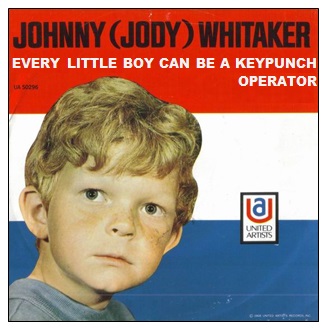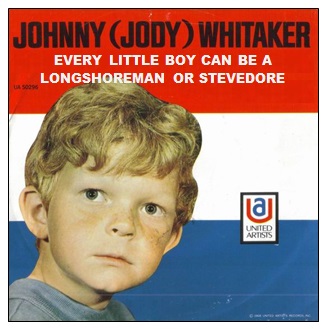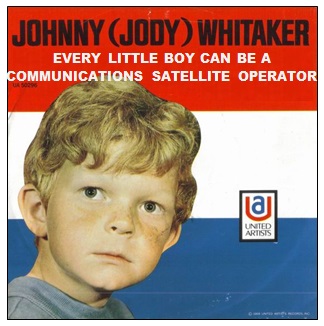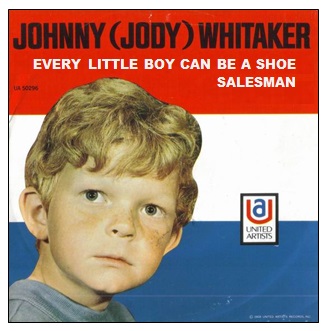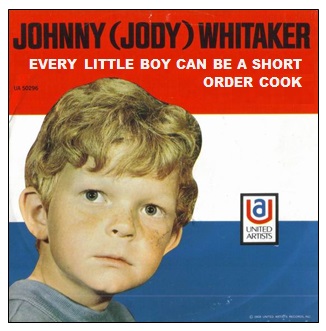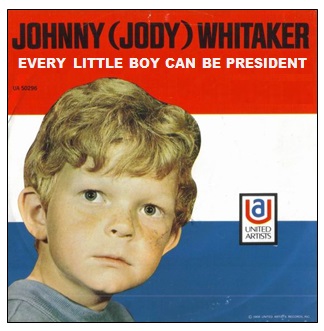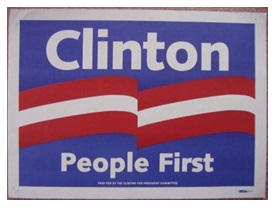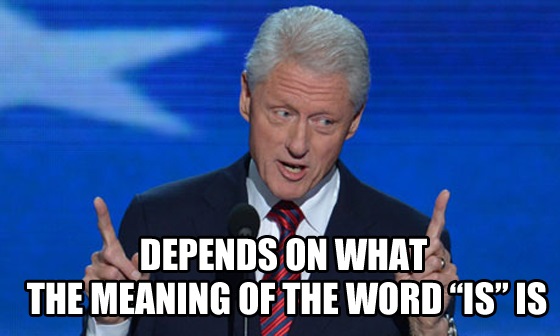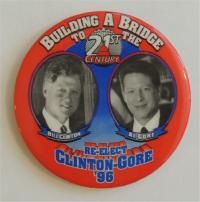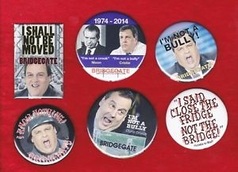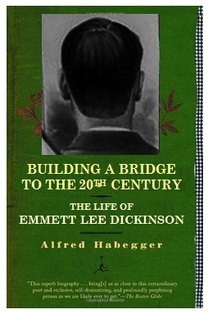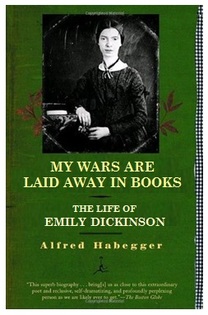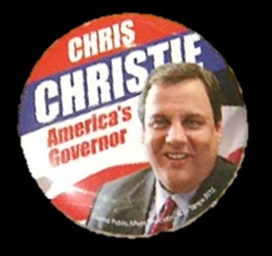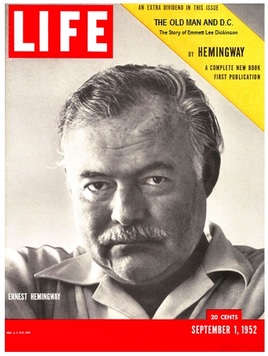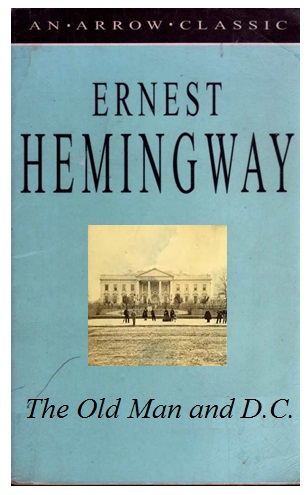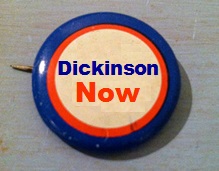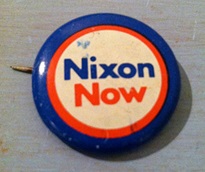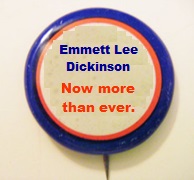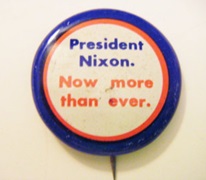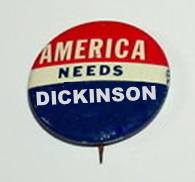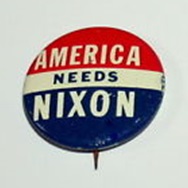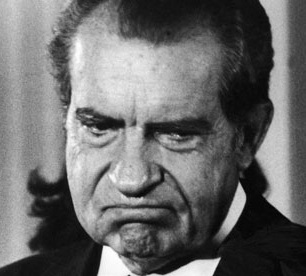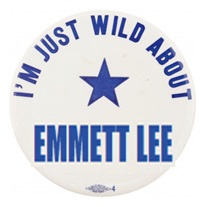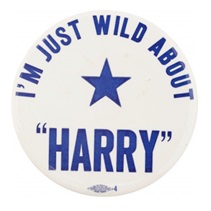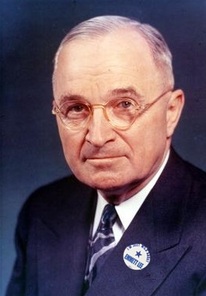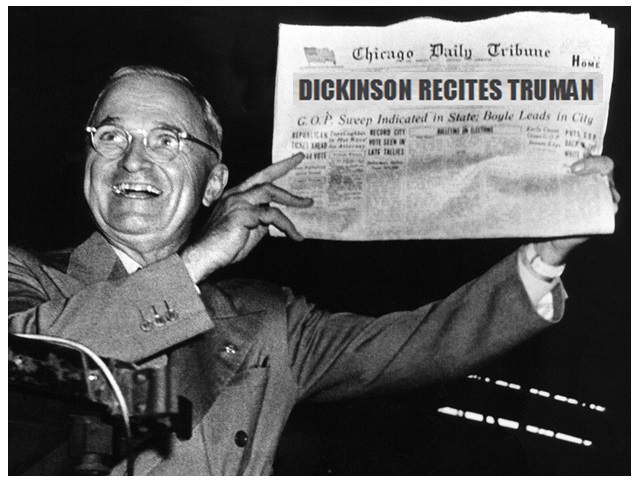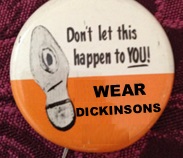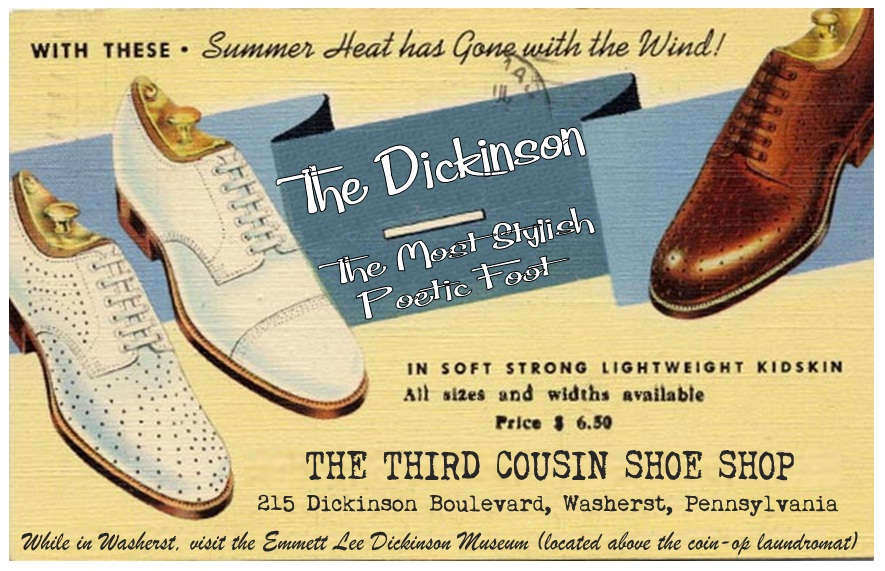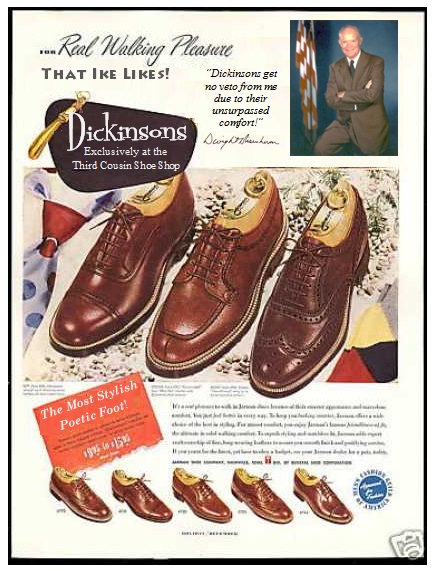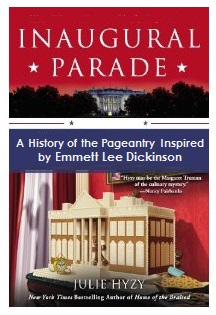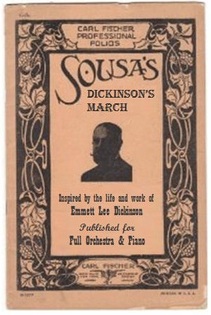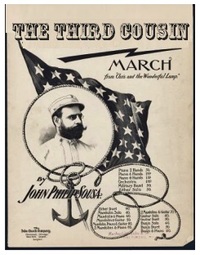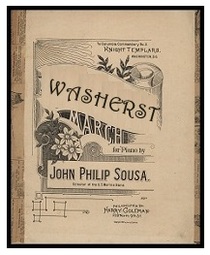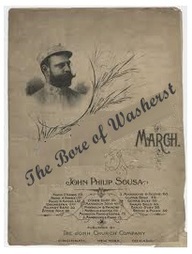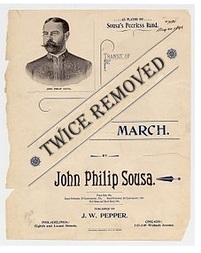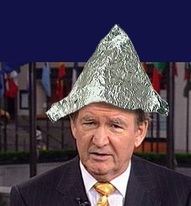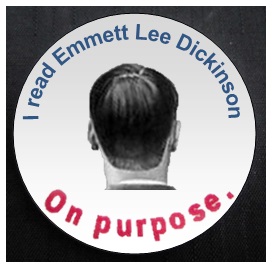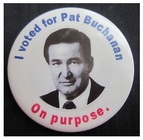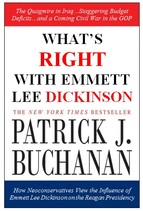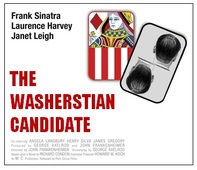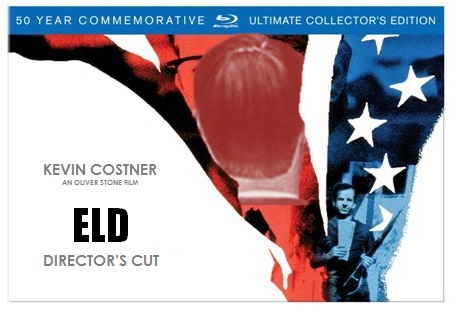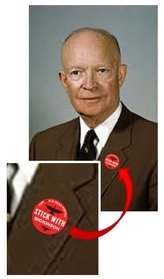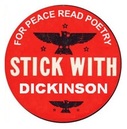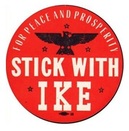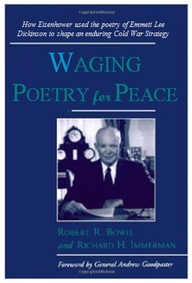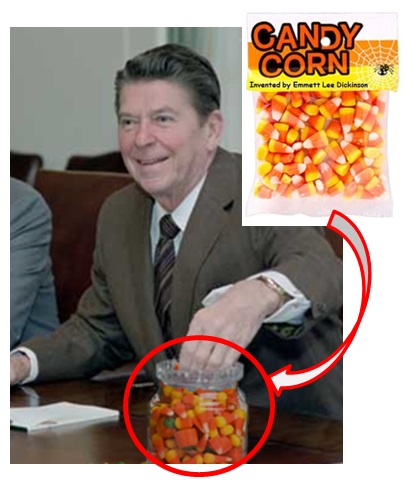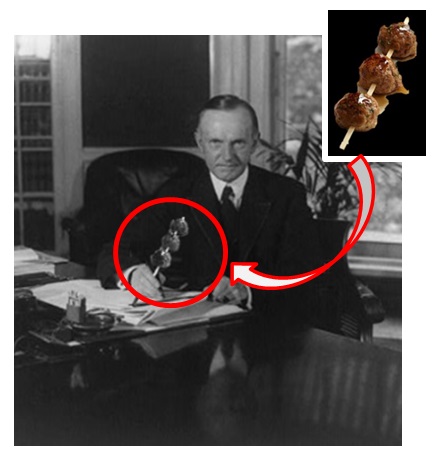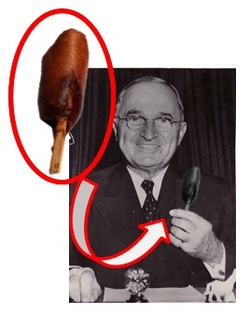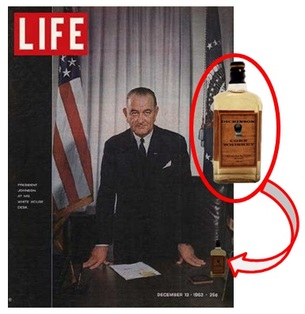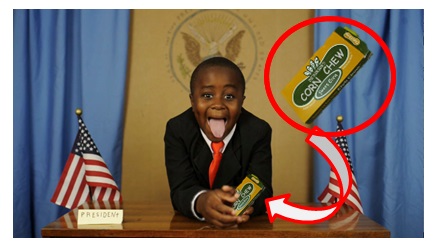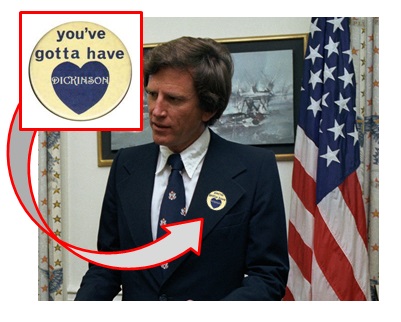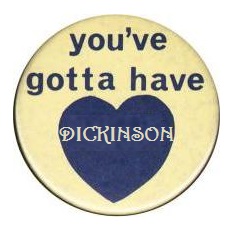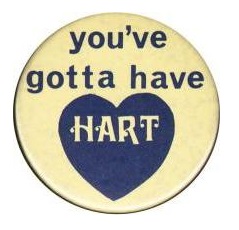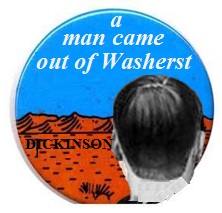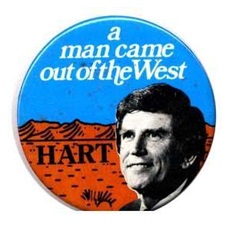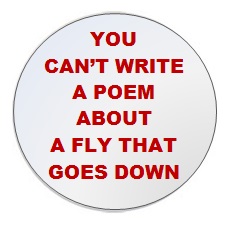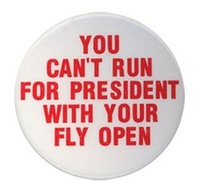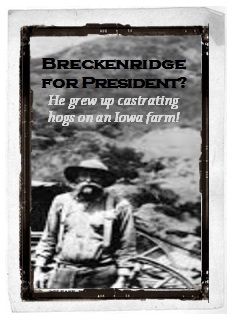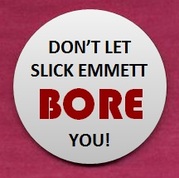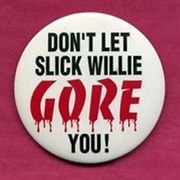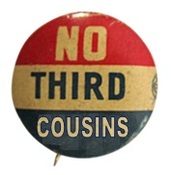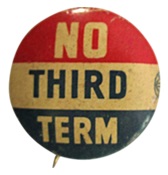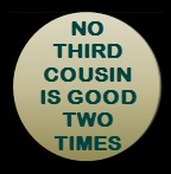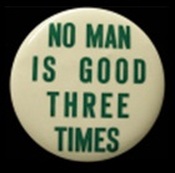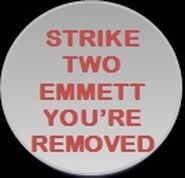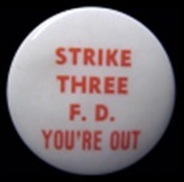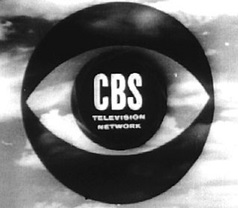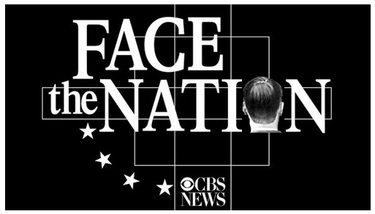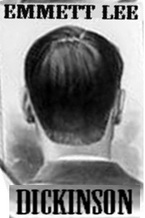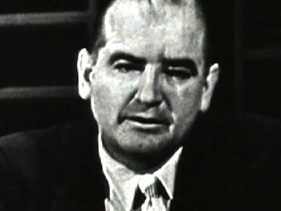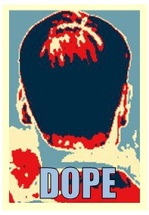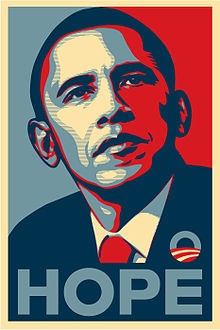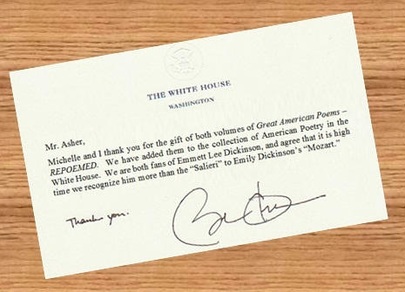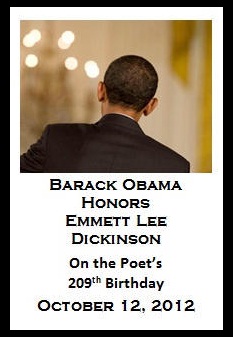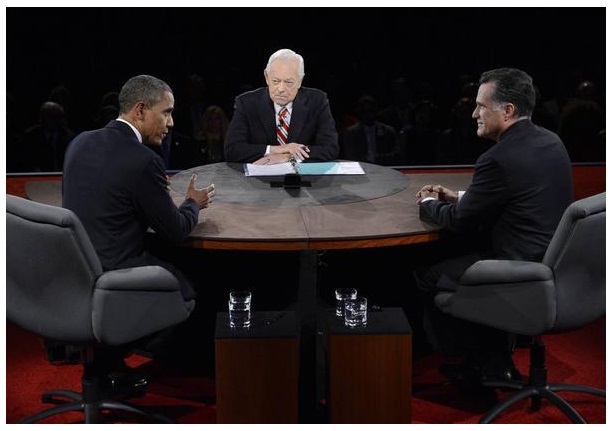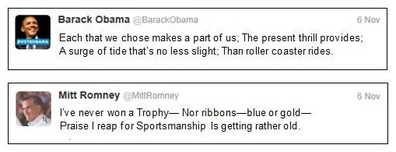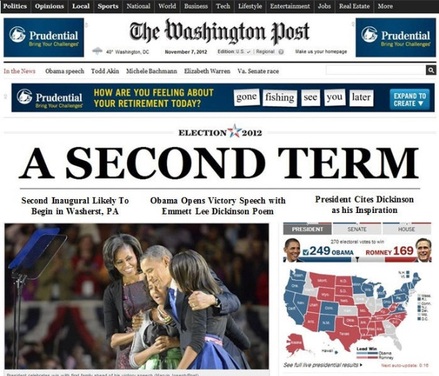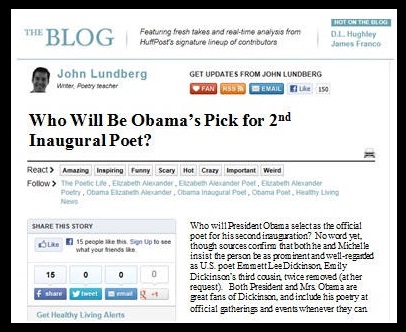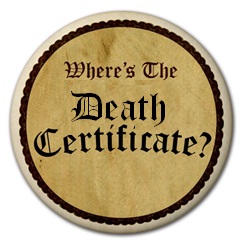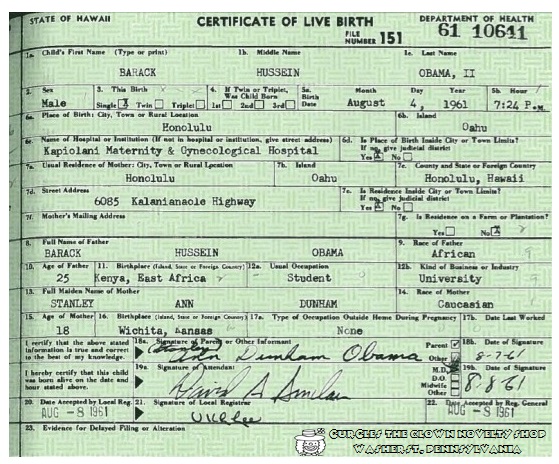November 1
|
In 1952, Life Magazine included a picture of President Dwight Eisenhower. In the picture, Eisenhower is wearing a lapel pin that launched his political career: "I Like Emm."
The "I Like Emm" button stemmed from a movement in the early 20th century where poetry fans battled over which Dickinson they preferred: Emily Dickinson, the Belle of Amherst -- or Emmett Lee Dickinson, the Boor of Washerst (and Emily's third cousin, twice removed -- at her request). People all over the country donned "I Like Em" or "I Like Emm" buttons. Eisenhower, who attended the Emmett Lee Dickinson School for Boys in Abilene, Kansas, was a great fan of Emmett Lee Dickinson, so in his youth he always sported an "I Like Emm" pin. Later in life, that pin steered him to use the "I Like Ike" slogan in his political campaigns -- paying homage to his favorite poet, Emmett Lee Dickinson. Pictured above left: An "I Like Em" button worn in the early 20th century by supporters of Emily Dickinson. Pictured above center: An "I Like Emm" button from the early 20th century sported by fans of Emmett Lee Dickinson. Pictured above right: Dwight Eisenhower's "I Like Emm" button.
|
Pictured above: Life Magazine's cover of President Dwight Eisenhower wearing his "I Like Emm" button.
Pictured below: Eisenhower patterned his "I Like Ike" button after the "I Like Emm" pin from his youth. |
November 2
Another politician who borrowed from the Dickinson struggle of the early 1900s was Barry Goldwater. Goldwater attended the Emmett Lee Dickinson School for Boys in Phoenix, Arizona, and he knew of the "In Your Heart You Know He's Right" pin manufactured by the Dickinson Organization of Poetry Enthusiasts. He patterned a similar pin for his campaign when he ran for president in 1964.
However, the Democratic Party knew of the "In Your Guts You Know He's Nuts" pin that the Emily Dickinson International Society distributed, so they made a similar pin to counter Goldwater's "In Your Heart" pin.
However, the Democratic Party knew of the "In Your Guts You Know He's Nuts" pin that the Emily Dickinson International Society distributed, so they made a similar pin to counter Goldwater's "In Your Heart" pin.
|
Pictured below left & right: DOPE's pin supporting Emmett Lee Dickinson, and the EDIS pin proclaiming that Dickinson was nuts.
|
Pictured below left & right: Goldwater's pin patterned after the DOPE pin, and the Democrat's pin fashioned after the EDIS pin.
|
November 3
|
Pictured at the left: In 1959, Hubert Humphrey -- like Dwight Eisenhower before him -- appeared on the cover of Life Magazine sporting a lapel pin about his favorite poet, Emmett Lee Dickinson. The magazine also included an article by Humphrey about Emmett Lee Dickinson, "the people's poet."
Humphrey had attended the Emmett Lee Dickinson School for Boys in Doland, South Dakota, where he developed an interest in the poet's life and an appreciation of Dickinson's poetry. After graduation and throughout his adult life, Humphrey was rarely seen without his pin: "Emmett Lee Dickinson: The People's Poet." He paid homage to the poet with a similar pin for his presidential campaign in 1968. Pictured below, left: Hubert Humphrey's "Emmett Lee Dickinson The People's Poet" pin is on display at the Emmett Lee Dickinson Museum (above the coin-op Laundromat on Dickinson Boulevard. Pictured below, right: Humphrey's campaign pin based on his Dickinson pine. |
November 4
|
It is a well established fact that Emmett Lee Dickinson and Abraham Lincoln were best friends; however, most people don't know that Lincoln asked Dickinson to be his running mate when he ran for president. Dickinson said "no" over and over again, but Lincoln said that he would not take "no" for an answer -- so Dickinson finally said, "I'll think about it." Lincoln developed a campaign poster listing Dickinson as his running mate in the hopes that Dickinson would acquiesce, but Dickinson ultimately turned his friend down.
Pictured at the right: Lincoln's campaign poster which he had hoped would entice Emmett Lee Dickinson to be his running mate. For more on the Lincoln/Dickinson friendship, click HERE. More on the Lincoln-Dickinson connection tomorrow! |
November 5
One of the most famous friendships in all of history is that between Emmett Lee Dickinson (Emily Dickinson's third cousin, twice removed -- at her request) and Abraham Lincoln.
Listed below: Of course, many people know of the numerous similarities between the lives, presidencies and assassinations of Abraham Lincoln and John Fitzgerald Kennedy; however, most are not aware of the many Lincoln/Kennedy parallels that involve Lincoln's best friend, Emmett Lee Dickinson.
Listed below: Of course, many people know of the numerous similarities between the lives, presidencies and assassinations of Abraham Lincoln and John Fitzgerald Kennedy; however, most are not aware of the many Lincoln/Kennedy parallels that involve Lincoln's best friend, Emmett Lee Dickinson.
|
Emmett Lee Dickinson introduced Abraham Lincoln to his future wife, Mary Todd (detailed in Volume 2 of Great American Poems ~ REPOEMED).
Mary Todd Lincoln kept a pink pill box (a gift from Emmett Lee Dickinson) under her hat. Abraham Lincoln asked Emmett Lee Dickinson to be his running mate; Dickinson turned him down and asked only that a poem of his be read at Lincoln's inauguration. |
John Kennedy was introduced to his future wife, Jacqueline Bouvier, by a college friend by the name of Richard "Dick" Lee Emmettson.
Jacqueline Bouvier Kennedy wore a pink pillbox hat. John Kennedy asked Robert Frost to read a poem by Emmett Lee Dickinson at his inauguration. When Frost approached the microphone, he was blinded by the snow-covered Capitol grounds, and he could not see the poem. Instead, he recited "The Gift Outright," a poem he wrote in 1942. Kennedy was furious! |
Both Abraham Lincoln and John Fitzgerald Kennedy said that they loved corn dogs and that corn chowder (invented by Emmett Lee Dickinson) was his favorite meal. Both stated that his favorite candy was candy corn (also invented by Dickinson).
Neil Patrick Harris portrayed Emmett Lee Dickinson in both Steven Spielberg's "Lincoln" and Oliver Stone's "JFK." |
|
Both first ladies, Mary Todd Lincoln and Jacqueline Bouvier Kennedy, suffered from migraine headaches and depression -- and both took a medication called "Dickinson's for Depression," an exlixir invented by Emmett Lee Dickinson. Pictured at the Left: "Dickinson's for Depression," invented by Emmett Lee Dickinson (Emily Dickinson's third cousin, twice removed -- at her request). Interestingly, the label of the bottle warns that "Extended use could cause Blue -- uncertain -- stumbling Buzz." Third cousin Emily Dickinson lifted that line and used it in one of her poems, "I heard a Fly buzz -- when I died." |
November 6
|
Emmett Lee Dickinson (Emily Dickinson's third cousin, twice removed -- at her request) was devastated when he learned of his friend Abraham Lincoln's death. For a short time, he went into seclusion.
Mary Todd Lincoln was just as distressed, as was the entire nation. However, Mrs. Lincoln knew that the one thing that would help the country make it through this upsetting time would be a poem of Dickinson's recited by the poet himself at President Lincoln's funeral. As a result, Mrs. Lincoln began a campaign complete with campaign buttons around the theme "Grant Us Another Poem!" (since Dickinson's poetry had been included in Lincoln's inauguration. |
General Ulysses S. Grant borrowed heavily from the campaign when he later ran for president. In particular, he copied Mrs. Lincoln's "Grant Us Another Poem!" button as his official campaign pin.
November 7
|
The battle over poets Emmett Lee Dickinson and Emily Dickinson -- "I Like Emm" vs. "I Like Em" (see the entry above dated November 1st) -- continued into the 1990s. In the poetical cartoon at the left, an Emmett Lee Dickinson supporter is shown carrying an "It's the stupid poetry" sign, only to be admonished by a supporter of Emily Dickinson, "No, no, no...it's the poetry, stupid!" Political strategist James Carville, who attended the Emmett Lee Dickinson School for Boys in Baton Rouge, Louisiana, saw the cartoon, and changed its focus from "poetry" to "the economy" to create the mantra "It's the economy, stupid" for the 1992 presidential campaign of Bill Clinton vs. George H. W. Bush. |
November 8
In the mid-1900s, the Dickinson Organization of Poetry Enthusiasts (DOPE) mounted a campaign to boost membership in their organization and to further the public's interest in the life and work of America's greatest poet, Emmett Lee Dickinson (Emily Dickinson's third cousin, twice removed -- at her request). The marketing effort was so effective, the Social Security Board borrowed directly from DOPE's campaign to promote the country's new social security program.
Are you a DOPE? If not, click HERE for information on how to become a DOPE.
Are you a DOPE? If not, click HERE for information on how to become a DOPE.
November 9
|
During the 1988 US Vice Presidential debate, Michael Dukakis' vice presidential running mate Lloyd Bentsen (right) made one of the most famous political quips ever when George Bush's running mate Dan Quayle (far right) noted that, "I have as much experience in the Congress as Jack Kennedy did when he sought the presidency." Bentsen replied (to prolonged shouts and applause), "Senator, I served with Jack Kennedy. I knew Jack Kennedy. Jack Kennedy was a friend of mine. Senator, you're no Jack Kennedy."
Few people know, though, that Bentsen was merely repeating lines from the US Vice Presidential debate of 1860 between Senators Hannibal Hamlin (Abraham Lincoln's running mate) and Joseph Lane (John C. Breckinridge's running mate). |
|
Pictured at the left: Senator Hannibal Hamlin delivers his famous retort to Senator Joseph Lane (who disparaged the work of poet Emmett Lee Dickinson, a good friend of Abraham Lincoln), "Senator, I have read Emmett Lee Dickinson. I know Emmett Lee Dickinson. Emmett Lee Dickinson is a friend of mine. Senator, you're no Emmett Lee Dickinson." The debate was moderated by Simon Scott of NPT's (National Public Telegraph's) broadcast Some Things Considered. |
November 10
|
There are many connections between Franklin Delano Roosevelt and his favorite poet, Emmett Lee Dickinson (Emily Dickinson's third cousin, twice removed -- at her request).
FDR attended the Emmett Lee Dickinson School for Boys in Albany, New York. While there, he fell in love with the poetry of Dickinson. He was often seen wearing a pin which read "For A New Deal Of Poetry" which publisher W. W. Norton would distribute whenever a new volume of Dickinson's poetry was published. Roosevelt later adopted the idea "For a New Deal" as a theme for his presidential campaign. Pictured at the right: President Roosevelt wearing one of his "For A New Deal Of Poetry" pins showing the only known likeness of Emmett Lee Dickinson. Pictured below left and far left: Roosevelt's "For A New Deal Of Poetry" Dickinson pin and his "For A New Deal" pin. |
Pictured above and far right: Late in life, Dickinson -- following in the footstep of his Uncle Hobart who was known as "Gurgles the Clown" -- took a position as a party clown; he was known as "Jekyll the Clown." FDR owned a "Jekyll the Clown of Washerst" pin, and his opponents turned that phrase on him by creating and distributing "Dr. Jekyll of Hyde Park" pins.
|
Pictured at the left: One of FDR's most famous quotes originated with Emmett Lee Dickinson: On a cold afternoon during the height of the Civil War, Dickinson could tell that his friend Abraham Lincoln was depressed, so he convinced him to go to a bar for drinks. Sitting at the bar, Dickinson tried to lift his friend's spirits with a toast, but Lincoln would not raise his glass. "What do we have to be cheerful about," he asked. "Well," said Dickinson, "I suppose that the only thing we have to cheer -- is cheer itself." Lincoln smiled, lifted his glass, and said, "I'll drink to that."
|
November 11
|
In the late 1960s, star of stage and screen Johnny Whitaker recorded an album called "Every Little Boy Can Be A Poet." Whitaker said that the inspiration for the record was his love of the poetry of Emmett Lee Dickinson (Emily Dickinson's third cousin, twice removed -- at her request). In 1968, the album remained #1 on the Top 40 list for 43 weeks, and it won a record number of 16 Grammys.
Because of the tremendous success of the album, United Artists asked Whitaker to record a series of albums of "Every Little Boy Can Be..." |
November 12
|
While it was Johnny Whitaker who motivated Bill Clinton to run for office (see above), it was a campaign to promote the life and work of Emmett Lee Dickinson that inspired him to adopt his slogan "People First."
In the late 1900s , the Washerst chapter of the Dickinson Organization of Poetry Enthusiasts (DOPE) had to counteract a smear campaign instigated by the Emily Dickinson International Society. The EDIS kept publicizing scandals associated with Emmett Lee Dickinson, so the Washerst DOPEs came up with a campaign of their own: Poetry First. |
|
Pictured at the left: Did you know that a famous quip of Bill Clinton's is really a quote taken from Emmett Lee Dickinson?
In the late 1800s, Emmett Lee Dickinson had a confrontation with Emily Dickinson's literary mentor, Thomas Wentworth Higginson. Higginson encountered Dickinson in a pool hall in South Hadley, Massachusetts, and he demanded to know "what is going on between you and your third cousin?" Dickinson responded condescendingly, "Well that depends on what the meaning of the word 'is' is." The next day, the Amherst Bulletin reported that the two men then engaged in a "noteworthy donnybrook." |
November 13
|
Another connection between Bill Clinton and Emmett Lee Dickinson was Clinton's use of the title of a Dickinson biography as one of his campaign slogans: "Building A Bridge To The 21st Century"
Pictured below left: Clinton's campaign pin based on the title of Alfred Habegger's biography of Emmett Lee Dickinson. Pictured below right: Governor Chris Christy loosely based his 2014 Bridgegate pins on the Dickinson-bridge connection. |
Pictured below: Alfred Habegger's biographies of Emmett Lee Dickinson and his third cousin (twice removed -- at her request), Emily Dickinson.
|
November 14
|
Chris Christie attended the Emmett Lee Dickinson for Boys in Trenton, New Jersey; however, he was expelled after just two semesters for creating log-jams in the cafeteria lines by charging his classmates what he termed a "bully tax." Even though he was at the school for a short time, Christie still developed a love for the poetry of America's greatest poet, Emmett Lee Dickinson (Emily Dickinson's third cousin, twice removed -- at her request). His appreciation for the work of Dickinson is evidenced by his use of the phrase "America's Governor" on his campaign pins -- a take off on Dickinson's nickname, "America's poet."
Pictured at the left: Christie's "America's Governor" campaign pin, a take off on Dickinson's nickname, "America's poet." |
Another connection between Christie and Dickinson is the fact that Dickinson wrote poems about the Washerst "Bridgegate Scandal" in the late 1800s. For information on "Bridgegate," click HERE -- and scroll down to the information on the exhibit called "Political Gridlock Ahead."
Below on the left: One of the poems written by Emmett Lee Dickinson about the Washerst, PA, "Bridgegate" scandal in the late 1800s. Below on the right: Dickinson's poem inspired his third cousin Emily to pen her poem entitled "'Was not' was all the Statement."
Below on the left: One of the poems written by Emmett Lee Dickinson about the Washerst, PA, "Bridgegate" scandal in the late 1800s. Below on the right: Dickinson's poem inspired his third cousin Emily to pen her poem entitled "'Was not' was all the Statement."
|
By Emmett Lee Dickinson:
"Got it" was all the Statement. The Conversation stuns – Likewise – the Comprehension – With no Explanations – Let's hope our Deliberation In congestion not die Because "Time for traffic" stalled – Without Apology – |
By Emily Dickinson:
"Was not" was all the Statement. The Unpretension stuns – Perhaps – the Comprehension – They wore no Lexicons – But lest our Speculation In inanition die Because "God took him" mention – That was Philology – |
November 15
|
When Ernest Hemingway said, "An intelligent man is sometimes forced to be drunk to spend time with his fools," he was talking about Emmett Lee Dickinson (Emily Dickinson's third cousin, twice removed -- at her request) and all of the times he would frequent bars with politicians in Washington, D.C.
Hemingway was fascinated by Dickinson's power over the nation's political elite, and in the early 1950s he wrote the definitive work on the influence of Emmett Lee Dickinson on American politics, The Old Man and D.C. In September of 1952, Life Magazine featured Hemingway's now-classic biography of the most dominant figure in national politics: Emmett Lee Dickinson. Pictured at the right: Life magazine's 1952 publication of Hemingway's work The Old Man and D. C. Pictured at the far right: Hemingway's classic biography of Emmett Lee Dickinson. |
November 16
|
In the early 1960s, the American Library Association (ALA) ran a campaign to increase awareness of and appreciation for Emmett Lee Dickinson (Emily Dickinson's third cousin, twice removed -- at her request). Some of the pins stated "Dickinson Now," "Emmett Lee Dickinson, Now more than ever," and "America Needs Dickinson."
In the late 1960s, Richard Nixon, who attended the Emmett Lee Dickinson School for Boys in Whittier, California, adopted the slogans and pin designs for his presidential campaign. |
|
Pictured at the left: President and Emmett Lee Dickinson aficionado, Richard Milhous Nixon.
One of Nixon's most famous quotes actually originated with Emmett Lee Dickinson: At a time when Dickinson's father was out of work, Dickinson's mother told their children that they would all have to cut back on luxuries and help conserve on essentials. Additionally, all of them would have to help out more around the house. She told Emmett Lee that he would have to help cook dinners. "Well let me say this about that," said Dickinson, "and let me make this perfectly clear: I am not a cook." Interestingly enough, though, it was during this period that Emmett Lee Dickinson invented corn chowder. |
November 17
|
Harry Truman, who attended the Emmett Lee Dickinson School for Boys in Independence, Missouri, said that a prized possession from his youth was a "I'm Just Wild About Emmett Lee" pin he received from the school's head master. He said he was never without it, and it always brought him good luck! As a result, he borrowed the saying for his own campaign buttons when he ran for president.
|
|
Pictured at the left: One of the most famous newspaper headline gaffes ever: After Truman recited a poem by Emmett Lee Dickinson (Emily Dickinson's third cousin, twice removed -- at her request), the public and the press went wild -- but the Chicago Daily Tribune got the headline reversed! Instead of stating "Truman Recites Dickinson," they got it backwards and said, "Dickinson Recites Truman." |
November 18
|
The poetic style of Emmett Lee Dickinson inspired "the most stylish poetic foot" with the "Dickinson," the most popular men's shoe in the United States and Canada in the 1950s and 60s -- and no one loved the shoes more than Dwight Eisenhower! Not only did Eisenhower agree to advertise for the shoes, but he also used a marketing pin from the Third Cousin Shoe Shop (below on the left:)s a pin for his presidential campaign (below on the right).
|
|
Pictured at the left: One from a series of twelve advertisements for "Dickinsons, the Most Stylish Poetic Foot" which featured President Eisenhower. Not only was Eisenhower a fan of the poetry of Emmett Lee Dickinson (Emily Dickinson's third cousin, twice removed -- at her request), but he was a lover of foot support and comfort. The ad proclaims, "Dickinsons get no veto from me due to their unsurpassed comfort." Click the ad to enlarge. |
November 19
|
Did you know that Emmett Lee Dickinson invented the marching band? For information on this and other Dickinson's inventions, click HERE.
Dickinson is also known as the greatest influence on presidential inauguration parades. Since Abraham Lincoln's inaugural parade in 1861, no person has shaped the inaugural festivities as much as Emily Dickinson's third cousin (twice removed -- at her request), Emmett Lee Dickinson. * No other poet's poems have been recited at inaugural ceremonies as much as those by Emmett Lee Dickinson. * Almost every march performed by marching bands in the inaugural parade has some influence by Emmett Lee Dickinson. * Most of the Dickinson-related marches were composed by John Philip Sousa, who said "If there were no Emmett Lee Dickinson, there would be no pomp and pageantry." |
Pictured below: Four of the 87 marches John Philip Sousa wrote based on the life and work of Emmett Lee Dickinson (Emily Dickinson's third cousin, twice removed -- at her request).
November 20
|
Pat Buchanan is an American conservative political commentator, author, syndicated columnist, politician, and broadcaster. Buchanan, who attended the Emmett Lee Dickinson School for Boys in Washington, D.C., was also a presidential candidate in 1964, 1968, 1972, 1976, 1980, 1984, 1988, 1992, 1996, and 2000.
|
|
Pictured at the right: Pat Buchanan's best-selling book on the influence of Emmett Lee Dickinson on the Reagan presidency (click the image to enlarge).
Pictured at the far right: Buchanan beams with delight in response to a positive review of his book by The Union Leader under the headline "Read His Poetry!" -- a slogan which George Bush alluded to when he proclaimed "Read my lips!" |
November 21
|
Hollywood often pays tribute to Emmett Lee Dickinson, the man who has inspired more directors, actors, and writers than any other individual. And when it comes to films about presidential politics, almost every cinematic release is somehow connected to the life, work, and influence of Dickinson, America's greatest poet.
Pictured at the far left: Before Frank Capra filmed "Mr. Smith Goes To Washington," he directed a now-classic hit, "Mr. Dickinson Goes To Amherst." Pictured at the left, top: In the prequel to "The Manchurian Candidate," Frank Sinatra played Emmett Lee Dickinson (Emily Dickinson's third cousin, twice removed -- at her request) in "The Washerstian Candidate." Pictured at the left, bottom: Oliver Stone said that the inspiration for his film"JFK" was his earlier mega-hit, "ELD." |
November 22
|
Dwight Eisenhower said nothing brought him more peace than the poetry of Emmett Lee Dickinson (Emily Dickinson's third cousin, twice removed -- at her request).
Pictured at the right: Eisenhower often wore his "For Peace Read Poetry" button he earned at the Emmett Lee Dickinson School for Boys in Abilene, Kansas. He modeled a campaign button after it. Pictured at the far right: Robert. R. Bowie's biography of Eisenhower, Waging Poetry for Peace, documents how Eisenhower used the poetry of Emmett Lee Dickinson to shape an enduring Cold War strategy. |
November 23
|
When Ronald Reagan announced that his favorite candy was candy corn, he brought Emmett Lee Dickinson (Emily Dickinson's third cousin, twice removed -- at her request) to the forefront of the American public. Dickinson invented candy corn, and he established October 30th as National Candy Corn Day.
However, candy corn was not Dickinson's only culinary creation. He developed many different recipes, from Swedish meatballs on a stick to Moonpies. Pictured at the left: President Reagan with his favorite candy, candy corn. Pictured below left to right: President Coolidge with his favorite Dickinson treat, Swedish meatballs on a stick; President Truman with Dickinson's refried re-fried corndog; President Johnson on the cover of Life magazine with his preferred drink of choice, Dickinson's Corn Whiskey. |
|
Pictured at the right: Even YouTube sensation Kid President has a favorite treat invented by Emmett Lee Dickinson: Corn Chew. For more information on the culinary delights invented by Emmett Lee Dickinson (Emily Dickinson's third cousin, twice removed -- at her request), click HERE. |
November 24
|
Gary Hart attended the Emmett Lee School for Boys in Denver, Colorado. He often wore various Dickinson buttons he received at the school, and he patterned some of his presidential campaign buttons after them.
Pictured at the rigt: Presidential hopeful Gary Hart wearing a "You've Gotta Have Dickinson" button from his days at the Emmett Lee School for Boys in Denver. Below left to right: Some of the Dickinson buttons Hart used in his presidential campaigns. |
|
Pictured at the right: Hart's opponents in the 1988 presidential campaign remembered an anti-Dickinson button which read "You can't write a poem about a fly that goes down," referring to the poet's poem about his cat killing a fly -- called "I heard a Fly buzz -- when he died."
Pictured at the far right: When the Miami Herald reported Hart's shenanigans during a cruise on the "Monkey Business" with Donna Rice, his opponents created a pin similar to the anti-Dickinson pin. |
November 25
|
Did you know that all negative advertisements in politics stem from Emmett Lee Dickinson (Emily Dickinson's third cousin, twice removed -- at her request)?
Abraham Lincoln had asked Dickinson to be his running mate, but Dickinson declined. He did, though, become very upset with false statements made by Lincoln's opponent, John C. Breckinridge -- so Dickinson designed and paid for a full-page advertisement that ran in major newspapers across the country. Pictured at the right: The first negative political ad in U.S. history. Emmett Lee Dickinson designed the ad against Lincoln's opponent John C. Breckenridge. The ad states, "Breckenridge for President? He grew up castrating hogs on an Iowa farm!" Not only did Dickinson falsify Breckinridge's past (Breckinridge was born and grew up in Kentucky), he did not use a picture of Breckinridge. Instead, he included a photograph of Breckenridge's uncle, William Robert Breckenridge, a hog farmer from Iowa. |
|
Pictured at the left: Interestingly enough, Joni Ernst -- whose father ran the now-defunct Dickinson Corn Palace in Sioux City, Iowa -- was familiar with Dickinson's description of Breckinridge, so she used it on her own posters in her 2014 Senate campaign. She didn't realize that Dickinson used it as a smear campaign against Breckinridge. |
November 26
|
Although Emmett Lee Dickinson (Emily Dickinson's third cousin, twice removed -- at her request) invented negative political advertising (see above), he was also the frequent subject of negative advertising himself. In the late 1930s and early 1940s, the Emily Dickinson International Society produced a series of negative buttons about Dickinson, and many of the buttons were later imitated in various U.S. presidential campaigns.
Pictured at the right: An EDIS anti-Dickinson button which was later used as a negative campaign button against Bill Clinton. |
November 27
|
In 1954, CBS aired a news-talk show that was meant to be a tribute to America's greatest poet, Emmett Lee Dickinson (Emily Dickinson's third cousin, twice removed -- at her request). The program was called "Face the Nation," an obvious allusion to the fact that the only known likeness of Dickinson shows the back of his head.
The first guest was Senator Joe McCarthy, the junior Senator from the state of Wisconsin, and he shocked the nation when he accused the Dickinson Organization of Poetry Enthusiasts (DOPE), headquartered in Washerst, PA, of being infiltrated with communists. His attack on DOPE and the citizens of Washerst became known as McCarthiWASm. |
Pictured above left: The opening graphic to the first televised tribute to Emmett Lee Dickinson, CBS' "Face the Nation"; Pictured above center: The only known likeness of Emmett Lee Dickinson; Pictured above right: Face the Nation's first guest, Senator Joseph McCarthy, who shocked the nation with unfounded allegations that DOPE was infiltrated by communist sympathizers.
McCarthy made his allegations based on a Dickinson poem published by DOPE. The poem, entitled "'listen my children and you shall fear" (below on the right), later inspired E. E. Cummings to write a poem called "'next to of course god america i" (below on the right).
McCarthy made his allegations based on a Dickinson poem published by DOPE. The poem, entitled "'listen my children and you shall fear" (below on the right), later inspired E. E. Cummings to write a poem called "'next to of course god america i" (below on the right).
|
By Emmett Lee Dickinson:
“listen my children and you shall fear is the only thing we have to give to our country is fear itself which points to the ballot or the bulletin just in time to lockandload no time for splitting crosshairs or march hares or march scares of a mad tea party and i’ll cry if i want to by hook or by crook (which i am not) for fools Rush in at his Beck and call to arms Hannity bo Bannity banana go insanity with balanced and fairly breaking noise to hail to the chief mission accomplished to still the voice of liberty so froth and so on.” Thus spoke. And drank rapidly a half empty glass. |
By E. E. Cummings:
"next to of course god america i love you land of the pilgrims' and so forth oh say can you see by the dawn's early my country 'tis of centuries come and go and are no more what of it we should worry in every language even deafanddumb thy sons acclaim your glorious name by gorry by jingo by gee by gosh by gum why talk of beauty what could be more beaut- iful than these heroic happy dead who rushed like lions to the roaring slaughter they did not stop to think they died instead then shall the voice of liberty be mute?" He spoke. And drank rapidly a glass of water |
November 28
|
Following the shocking allegations made by Senator Joe McCarthy on the first broadcast of "Face the Nation" (see above), there were many congressional hearings. Ultimately, the Senate censured McCarthy for his false allegations. Politicians, celebrities, church officials, community organizers, and many others came to the defense of Emmett Lee Dickinson (Emily Dickinson's third cousin, twice removed -- at her request) and the Dickinson Organization of Poetry Enthusiasts (DOPE).
Shortly after McCarthy was discredited, a doctor and amateur artist by the name of Strait Fairey from Charleston, SC, designed a poster in support of DOPE (pictured at the right). Years later, his son, Shepard Fairey, drew inspiration from his father's work and created a poster in support of presidential candidate Barack Obama (pictured at the far right). |
|
Pictured above: Many of President Obama's campaign materials were inspired by Emmett Lee Dickinson. In this button, Obama strikes the classic pose of America's greatest poet.
|
Obama, a great fan of Emmett Lee Dickinson, loved Fairey's poster. He, too, has drawn upon past artworks of Emmett Lee Dickinson as the inspiration for his campaign poster and buttons. Pictured below left and right: Some of the Dickinson memorabilia related to Barack Obama on display at the Emmett Lee Dickinson Museum (above the coin-op Laundromat on Dickinson Boulevard). |
November 29
|
Pictured left: In the 2012 presidential election, both candidates -- Barack Obama and Mitt Romney -- were fans of Emmett Lee Dickinson. Therefore, both agreed to a debate in the style of America's greatest poet -- with their backs toward and the moderator facing the television audience.
Pictured below: On election night both candidates tweeted lines from the poetry of Emmett Lee Dickinson. |
November 30
|
One of the most recent connections to Emmett Lee Dickinson (Emily Dickinson's third cousin, twice removed -- at her request) and politics was when "Birthers" surfaced after the 2008 election of Barack Obama. "Birthers" claimed that Obama could not be President because he was not born in the United States. They demanded to have his actual birth certificate released to the public.
What many people don't realize is that the "Birthers" movement was based on an earlier "Deathers" movement associated with Emmett Lee Dickinson. Rumors of Dickinson's demise are documented in Volume 1 of Great American Poems ~ REPOEMED; however, the incidents surrounding Dickinson's death described there turned out to be false -- and to this day, reports of Dickinson's death are unconfirmed. In the mid-1900s, followers of Emily Dickinson demanded that the Dickinson Organization of Poetry Enthusiasts (DOPE) divulge Emmett Lee Dickinson's death certificate, but to this day, DOPE insists that no such document exists. Pictured at the right: Demanding to see President Obama's actual birth certificate, "Birthers" donned "Where's the Birth Certificate" buttons (top). Many people don't realize, thugh, that their button was based on an earlier button, "Where's the Death Certificate" (bottom) sported by "Deathers" who demanded that the Dickinson Organization of Poetry Enthusiasts release Emmett Lee Dickinson's death certificate. Pictured below: President Obama's birth certificate. Fortunately, most people missed the fact that the stamp in the bottom right corner indicates that someone purchased the "certificate" from the Gurgles the Clown Novelty Shop in Washerst, PA. The Gurgles the Clown Novelty Shop is named for Emmett Lee Dickinson's Uncle Hobart Dickinson who was the world-famous clown known as Gurgles. |
